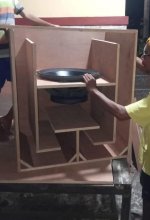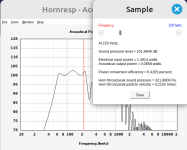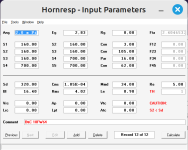Hi guys! Are there any DIY tapped kick horn projects anywhere in the world? Or have such projects already been realized and I haven't found them? Or to put it another way: There are no TH kicks because it is perhaps impossible to construct a tapped horn as a kick horn? Or has no one tried to develop one yet? Questions, questions! I'm hoping for a little exchange of experience from the experts!
Best regards
Best regards
The ROAR-series are great tapped pipe kick "horns". https://www.martinsson.cc/blog/index.php?m=03&y=17&entry=entry170302-180251
But you could easily make a more "normal tapped horn with a 10 inch mis driver tuned to whatever passband you need. They tend to have a quite limited bandwidth though.
But you could easily make a more "normal tapped horn with a 10 inch mis driver tuned to whatever passband you need. They tend to have a quite limited bandwidth though.
Hi!
ROAR are very big and ROAR are subwoofers that start loading at 40-45Hz. I know very well that tapped horns can play dry and subjectively kick well. But ROAR are not purebred kick horns that were developed for this purpose.
My question was whether anyone has tried it and had success?
The search continues...
ROAR are very big and ROAR are subwoofers that start loading at 40-45Hz. I know very well that tapped horns can play dry and subjectively kick well. But ROAR are not purebred kick horns that were developed for this purpose.
My question was whether anyone has tried it and had success?
The search continues...
There is the Cubo Kick.
https://www.freespeakerplans.com/plans?view=article&id=54:cubo-kick
But first question is define what frequencies you think a kick cabinet should cover?
https://www.freespeakerplans.com/plans?view=article&id=54:cubo-kick
But first question is define what frequencies you think a kick cabinet should cover?
@Xoc1
Thanks for the answer, but I'm not looking for a bandpass horn.
I'm specifically looking for tapped horns and nothing else.
I haven't found a tapped kick horn anywhere yet.
So I thought I'd ask the international tapped horn community whether such a project is already known (worldwide)!
I am currently in the process of developing a 12" tapped kick horn myself.
I have been researching this for a long time. But I have found absolutely NOTHING on the internet.
The TKH12 that I am currently working on should cover a range of 60-80Hz to 200-250Hz. That should be enough for most uses. Since a tapped horn rarely plays over 2 octaves, that should theoretically be possible.
I have already developed a few tapped horns, but unfortunately have not yet seen a tapped kick horn. Let alone. Most kick horns are either bandpass horns or frontloaded horns.
That is why I am very curious to see whether my venture has a chance of success and am looking for experiences with it.
Kind regards
Thanks for the answer, but I'm not looking for a bandpass horn.
I'm specifically looking for tapped horns and nothing else.
I haven't found a tapped kick horn anywhere yet.
So I thought I'd ask the international tapped horn community whether such a project is already known (worldwide)!
I am currently in the process of developing a 12" tapped kick horn myself.
I have been researching this for a long time. But I have found absolutely NOTHING on the internet.
The TKH12 that I am currently working on should cover a range of 60-80Hz to 200-250Hz. That should be enough for most uses. Since a tapped horn rarely plays over 2 octaves, that should theoretically be possible.
I have already developed a few tapped horns, but unfortunately have not yet seen a tapped kick horn. Let alone. Most kick horns are either bandpass horns or frontloaded horns.
That is why I am very curious to see whether my venture has a chance of success and am looking for experiences with it.
Kind regards
Shrink this to ~ 100-120cm(86-72hz) and make sure the ‘other’ resonator is 33-40cm respectively or you end up with some phase/decay funk @ 3 x Fb(260-216hz)?
This is a tapped ‘horn’, it’s just arranged the resonator shape to benefit the efficiency and bandwidth ‘smoothness’ I suppose
This is a tapped ‘horn’, it’s just arranged the resonator shape to benefit the efficiency and bandwidth ‘smoothness’ I suppose
Attachments
Clearly, I’m not an ‘expert’ , but the bandwidth is super limited after 3x Fb, unless you use the port assist or tapered resonator to stretch Fb below the 3 and 4 x 1/4 wavelength where it goes 💩
I’m Assuming this particular drivers cone isn’t up to the task either?


https://www.parts-express.com/B-C-12PE32-12-Midbass-Speaker-294-660?quantity=1
I’m Assuming this particular drivers cone isn’t up to the task either?
https://www.parts-express.com/B-C-12PE32-12-Midbass-Speaker-294-660?quantity=1
Last edited:
Viktor,Or to put it another way: There are no TH kicks because it is perhaps impossible to construct a tapped horn as a kick horn?
The DSL TH-Mini proves it is possible to construct a tapped horn covering the range of 50-200Hz:
The TH-Mini's frequency, phase response and size are all like ~1.5/1 "scale model" of the TH-15, I'd expect it's internal fold pattern to look something like this:
Tapped horns excel in providing good low frequency (LF) range in a smaller volume than a front loaded horn (FLH).The TKH12 that I am currently working on should cover a range of 60-80Hz to 200-250Hz. That should be enough for most uses.Most kick horns are either bandpass horns or frontloaded horns.
A FLH requires a much larger mouth area to have as smooth response down in the 30Hz range as a TH.
When the LF range of a FLH is reduced to the "kick" range of 60-80Hz, the mouth no longer needs so much area.
FLH excel in transient response, providing a better sensation of impact that defines "kick" than a TH.
Most anyone that is chasing the ultimate "kick" would prefer a FLH over a TH for the 60-250Hz range.
Art
Hi!
With all due respect, nothing against the forefather of the tapped horn, but the measurement is very "embellished". And I think that's not without reason. The bandwidth is only shown in the measurement up to 200Hz. What happens after that, how strong the resonances are, is basically kept secret from us. I also don't see how much smoothing has been done. If you were to use the TH Mini as a subwoofer and separate at 120Hz, then that would actually be secondary. But if I want to use the bandwidth and separate at 200Hz, for whatever reason, then I can't get any useful information from the measurement. Unfortunately!
Multiple folds, like in your picture, are counterproductive for the fundamental and midrange, because the frequent redirections combat what we want to preserve, namely the bandwidth. This is a good trick when constructing the tapped horn, because the frequent redirection of the line breaks or weakens the resonances. But if you want to reach as high as possible above 200 Hz in the bandwidth, you can't fold too often.
The question I ask myself! Why is an FLH preferred over a TH? Maybe because there are no TH kicks? Or because it is easier to construct an FLH as a kick horn than as a TH? Sure, an FLH has no resonances and the bandwidth is very large. But the whole housing is also large. Of course, if you need this large bandwidth and can live with the size, then an FLH is the first choice. But to say across the board that an FLH is better, I personally don't have a comparison! And that is largely because there are no good TH kicks. And that brings me back to my original question in the opening post!
Kind regards
With all due respect, nothing against the forefather of the tapped horn, but the measurement is very "embellished". And I think that's not without reason. The bandwidth is only shown in the measurement up to 200Hz. What happens after that, how strong the resonances are, is basically kept secret from us. I also don't see how much smoothing has been done. If you were to use the TH Mini as a subwoofer and separate at 120Hz, then that would actually be secondary. But if I want to use the bandwidth and separate at 200Hz, for whatever reason, then I can't get any useful information from the measurement. Unfortunately!
Multiple folds, like in your picture, are counterproductive for the fundamental and midrange, because the frequent redirections combat what we want to preserve, namely the bandwidth. This is a good trick when constructing the tapped horn, because the frequent redirection of the line breaks or weakens the resonances. But if you want to reach as high as possible above 200 Hz in the bandwidth, you can't fold too often.
The question I ask myself! Why is an FLH preferred over a TH? Maybe because there are no TH kicks? Or because it is easier to construct an FLH as a kick horn than as a TH? Sure, an FLH has no resonances and the bandwidth is very large. But the whole housing is also large. Of course, if you need this large bandwidth and can live with the size, then an FLH is the first choice. But to say across the board that an FLH is better, I personally don't have a comparison! And that is largely because there are no good TH kicks. And that brings me back to my original question in the opening post!
Kind regards
By the way, I know this thread here
I haven't seen any designs which focus on midbass as opposed to lower extension.
Any designs for midbass tapped horns to be coupled with large sub-bass tapped horns? (potential to mate up to smaller midrange horns)
Possible goals:
Figure 80-300hz (less than 2 octaves)
Smallish size, made from 1/2" Baltic Birch for lightweight
12-15" driver for $200 USD or less price
Just an idea!
Btw not sure if anyone has seen (heard) the 3 way Void horn tops, but I have seen them at the last few parties I've been to. The setups were crossed right to double 18's and lacked some midbass IMO...
Any designs for midbass tapped horns to be coupled with large sub-bass tapped horns? (potential to mate up to smaller midrange horns)
Possible goals:
Figure 80-300hz (less than 2 octaves)
Smallish size, made from 1/2" Baltic Birch for lightweight
12-15" driver for $200 USD or less price
Just an idea!
Btw not sure if anyone has seen (heard) the 3 way Void horn tops, but I have seen them at the last few parties I've been to. The setups were crossed right to double 18's and lacked some midbass IMO...
- m R g S r
- Replies: 61
- Forum: Subwoofers
80 -200 is possible with a normal tapped horn, but you need one more resonator to gain efficiency and a wide bandwidth. I understand you don´t want a higher order quarterwave design, but it is the only way I can match your range without loosing efficiency while using a tapped positive acoustic feedback design. 100dB/1w/1m from one 10 inch driver in 2.0 Pi is not bad.should cover a range of 60-80Hz to 200-250Hz
Attachments
@Circlomanen
Thank you for the simulation, but that's not what I'm looking for. I can do the simulation and have already done it. I have no problems with simulating. I'm looking for experience. The question of comparable, already realized DIY projects also remains open! Has nobody really tried this yet?
Thank you for the simulation, but that's not what I'm looking for. I can do the simulation and have already done it. I have no problems with simulating. I'm looking for experience. The question of comparable, already realized DIY projects also remains open! Has nobody really tried this yet?
Out of interest, where would you put the DSL SH50/SH60 50Hzodd to 325Hz range in that kick equation?Most anyone that is chasing the ultimate "kick" would prefer a FLH over a TH for the 60-250Hz range.
69, there is a problem that comes at you fast with increasing frequency, the wave lengths get short fast. If you want a tapped horn to play cleanly to 200Hz, I think you have less than 17” path lengths to work with.
In my motorsports world, ducted airflow states that every 90 degrees is a “turn”. The Danley TH Mini is not folded like the one Art referenced. The TH that Art referenced has eight turns. The TH Mini has only five.
Maybe with a brick wall filter you could approach 200Hz with a TH Mini but in my experience they don’t sound great much above 100-120Hz. My experience is that I own 12 of them.
A possible reason that you can’t find what you are looking for is that there are better solutions at the upper frequencies you want to use this horn at.
Give one of your simulations a go in the physical world and see what you can make. You may have to find your own evidence.
Barry.
In my motorsports world, ducted airflow states that every 90 degrees is a “turn”. The Danley TH Mini is not folded like the one Art referenced. The TH that Art referenced has eight turns. The TH Mini has only five.
Maybe with a brick wall filter you could approach 200Hz with a TH Mini but in my experience they don’t sound great much above 100-120Hz. My experience is that I own 12 of them.
A possible reason that you can’t find what you are looking for is that there are better solutions at the upper frequencies you want to use this horn at.
Give one of your simulations a go in the physical world and see what you can make. You may have to find your own evidence.
Barry.
How about 2 turns each under 90 deg?

The trapezoidal shape allows more control of the horn profile.
The trapezoidal shape allows more control of the horn profile.
Yes, it looks like the TH-Mini has a THAM style fold, not line the one used in the TH115 or TH118.[snip] In my motorsports world, ducted airflow states that every 90 degrees is a “turn”. The Danley TH Mini is not folded like the one Art referenced. The TH that Art referenced has eight turns. The TH Mini has only five.
I'm not really the biggest fan of that type of fold because of the length of the baffle and the placement of the high-pressure zone at one of the box's external panels (rather than internal like the TH115), but if it works ..., 🙂
The bass-reflex SH-50 sensitivity in the 70Hz range is only 97dB 1w/1m, from 100-200Hz drops to only ~93dB.Out of interest, where would you put the DSL SH50/SH60 50Hzodd to 325Hz range in that kick equation?
In the upper range of the 2x12", it reaches only ~100dB. Conical horns of that size don't provide much gain in the "kick" range.
A 2x12" exponential horn of similar volume of the could hit ~105dB over the 80-325Hz range.
My mistake.Yes, it looks like the TH-Mini has a THAM style fold, not line the one used in the TH115 or TH118.
Same answer as before: FLH excel in transient response, providing a better sensation of impact that defines "kick" than a TH.The question I ask myself! Why is an FLH preferred over a TH?
Even a single-fold two-turn TH like in post #17 is going to "kick" with two mixed arrival times, one from the front of the driver, and one from the rear.
It may measure slightly louder in SPL than a FLH of the same volume, but won't have the same impact.
Anyway, build both and compare for yourself to hear the difference.
For chuckles I put together a quick 50 Hz TH sim using one of Dayton Audio's new PA 12" drivers. Oof. The thing will easily eat up 700+W without exceeding Xmax, and provide over 126dB in its passband, which looks very similar to the TH-Mini's published passband. The box would be easier to move around too (another thing I don't like about THAM type fold - it results in a box with a squarish profile - the SS type fold produces a more elongated box - put wheels in the bottom corner, tip, and you're good to go, and it provides a higher mounting point for any "top" that you want to mount on top of it).
But yes, even though the FR suggests that it is useful from 50 Hz to 200 Hz, that upper "bump" in the FR is around 130 Hz, and I probably won't consider crossing over any higher than that.


But yes, even though the FR suggests that it is useful from 50 Hz to 200 Hz, that upper "bump" in the FR is around 130 Hz, and I probably won't consider crossing over any higher than that.
- Home
- Loudspeakers
- Subwoofers
- Tapped-Kick-Horn



